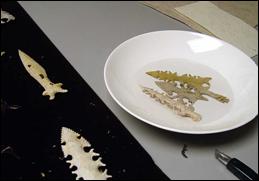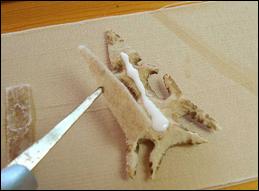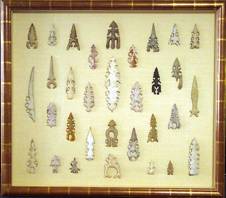 Photo 1
Photo 1
Removed heads soaking in water.
In a recent framing project I had to remove 32 collectible arrowheads from old black velvet and re-adhere them in a new arrangement to silk using a non-invasive, reversible method. They had been glued with some form of PVA—white glue—that was reversible with water after dry. As each piece was removed from the old velvet backing it was soaked in plain water (photo 1). Using a bamboo knife the softened adhesive allowed any remaining fabric to be gently scraped from the stone arrowhead (photo 2). This was all the easy part.
 Photo 1
Photo 1
Removed heads soaking in water.
 Photo 2
Photo 2
Softened fabric easily scrapes with a bamboo knife.
Each head was to be fitted with a strip of polyester felt that matched the color of the silk that would function as a buffer between the solid substrate and the stone arrowhead (photo 3). This also lifted each piece slightly allowing it to visually float off the backing. I tested all of the PVA glues I had on hand and they were either too thin — and totally soaked into the felt or they didn't reverse in water. I conferred with Hugh Phibbs who recommended I check into EVAs rather than PVAs.
 Photo 3
Photo 3
Polyester felt cut to fit, ready for glue.
PVA stands for polyvinyl acetate, EVA stands for ethylene vinyl acetate, both of which are very broad classifications of adhesive. There are thousands of different formulations of PVAs and EVAs on the market, all of which have very distinct properties with respect to viscosity, drying times, dry film characteristics, etc. Therefore, it is critical to research products by type and manufacturer when choosing a wet adhesive for any specific project.
Polyvinyl Acetate (PVA)
Basic PVA is probably the most common adhesive on the market, and is designed to work on porous materials, but requires pressure to properly bond. Some are pH neutral, fast setting, colorless when dry, and may remain flexible with age. It is a rubbery synthetic vinyl polymer adhesive component of a widely-used type of liquid vinyl resin glue, referred to variously as wood glue, white glue, carpenter's glue, school glue or PVA glue. Conservation grade PVAs are often permanent when dry, they can still absorb water if submerged or exposed to constant humidity.
Lineco Neutral pH Adhesive (PVA) was too thin and soaked into the felt. Jade 403 is a highly favored general purpose PVA, pH neutral, acid free, resin based, thermoplastic adhesive that is fast drying, water soluble when wet, and permanent when dry. Most commonly used for book and box making applications, adhering paper to paper, cloth to wood or leather, filling in cracks in art canvases and repairing ceramic objects.
Ethylene Vinyl Acetate (EVA)
EVAs are formulated as water reversible formulations. They maintain softness and flexibility, clarity and gloss, barrier properties, low-temperature toughness, and resistance to UV radiation. Jade R is a water reversible EVA, that is an acid free, archival adhesive similar to Jade 403 but is water reversible after it has dried. Ideal for conservation work where reversibility is of concern, it is excellent for bonding paper, board, fabric, canvas, leather and films to other like surfaces. Evacon R is another conservation grade, water-soluble, non-plasticized EVA for fusing papers and boards. It is a mild smelling white liquid with a pH 7-8. This one was recommended by Hugh Phibbs as the reversible wet glue solution to my bonding stone to fabric.
Beva Gel is a mixture of water-soluble EVA and acrylic resins, fairly thick in viscosity compared to Jade R. The Beva line was designed for relining and painting conservation, which are an excellent adhesive which bonds to a wide range of surfaces and also heat bonds at low 150-160ºF temperatures when dry. Beva products are permanent thermosetting adhesives that require toluene, xylene, isopropyl alcohol or ethanol as solvents.
EVA of Choice
Though I tested many, I opted for Jade R as the perfect solution. It dried fast, held well while maintaining a flexibility, did not soak through the felt and proved to be reversible after dry (photo 4). Not all PVAs and EVAs are created equal. Know what you need, then select the correct adhesive for those needs.
 Photo 4
Photo 4
Completed reframe.
END
Copyright © 2012 Chris A Paschke
For more articles on mounting basics look under the mounting section in Articles by Subject.
Additional information on all types of mounting is found in:
The Mounting and Laminating Handbook, Second Edition, 2002,
The Mounting And Laminating Handbook, Third Edition, 2008 and
Creative Mounting, Wrapping, And Laminating, 2000 will teach you everything you need to know about getting the most from your dry mount equipment and materials as an innovative frame designer.
All books are available from Designs Ink Publishing through this website.
Chris A Paschke, CPF GCF
Designs Ink
Designs Ink Publishing
785 Tucker Road, Suite G-183
Tehachapi, CA 93561
P 661-821-2188
chris@designsinkart.com